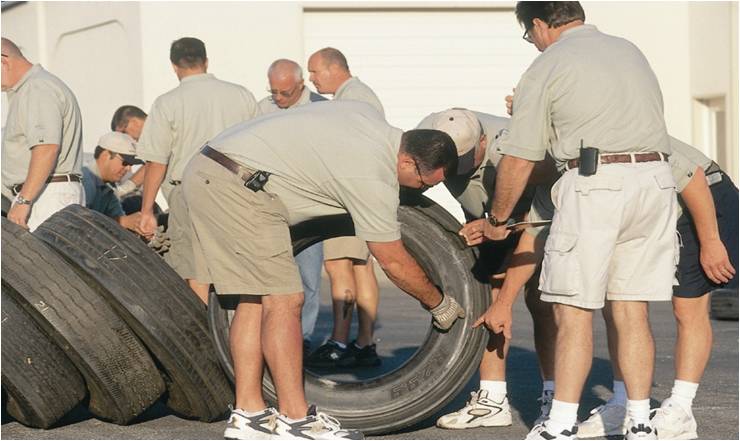Everybody wants to get what they can out of tires: the last rotation, the lowest cost per mile and the cheapest cost, while putting air in them on a daily basis. Different fleet managers or accounting departments want to have inventory taken in various ways and at various times—some want to take inventory annually, semi-annually or quarterly and some every Friday or even on daily basis. They may delegate it to the janitor with a clipboard to count the tires and rims on the daily or weekly basis. They lock up the tires with a chain or cable. Have you ever threaded a chain or cable thought the tires? Or tried climbing around the tires in a white shirt? It’s a waste of time and effort. But fleet managers take inventory on tires because we want to eliminate theft, tires unaccounted for, or perceived tire needs. In most cases, the tires that maybe missing are, in fact, probably on one of your pieces of equipment..
Now that we have counted all the tires, is our own shop’s tire count the most important count to have? Do we know, really know, what has gone out for cap? What is being capped? What is being scrapped? Sure, we do a scrap analysis and we know, or should know, what is being rejected. But do we really know (and balance like a checkbook) what has gone out, and what has been returned? In most cases, sophisticated companies have forms; some have papers filled out on a detailed sheet describing the tires picked up. Some have bar code labels that that are put on each tire as they are picked up with the details on the work order—DOT number, tread depth, tread design desired, etc.
Next. the tires go to the tire company—hundreds of tires, piles of tires. Everywhere you look, a sea of tires here, a sea of tires there. All moved by a tire employee from location to location, and finally to a point of capping. Then, the tires are capped and returned at some point—the next week?—or stored at the capper for future call for inventory. It’s typically whatever your program calls for. In a lot of loosely managed fleets—the place with the chains—someone is not available when the tires are picked up or returned, and most do not review the paper work on both ends of the transaction—10 tires picked up and 10 returned. Because of the complexity of the tire’s repair prior to capping, not every tire that is picked up is returned on the next delivery.
Some fleets do try to keep the transactions straight. They will try to post it on a spreadsheet, file the papers and try to account for the ins and outs, but in reality, most give up because we tend to overcomplicate the process. In most of these cases, an audit would be ugly. The tire companies also try hard to also keep it straight—they cap the tire and invoice for the tire when completed. But in the sea of tires, I know that it is easy to misplace some tires. They cannot have enough chains.
There is an easy way to control this, a very easy way to stand up to an audit. In a recent situation I witnessed, as with many fleets before, there was an out of balance situation that showed 206 tires unaccounted for in a ten-month period. After an internal audit by the fleet and tire company, they discovered that 20 casing credits had not been accounted for and the fleets accounting department “forgot to pass on the credit invoices.” 30 tires somehow never got to the scrap analyses during the reviews; some tires were in the process of being capped and some were in inventory for future delivery. The real story is that there were 76 tires missing, and no one could find the tires. Yet we did have a simple inventory book with information. In a few cases, we did find that there were ten tires picked up, but eight tires arrived at the tire company. Two tires must have fallen of the truck during transporting the tires to the cap shop.
In summary, the creditable tire company was happy to participate in the fleet’s audit, or inventory balancing. There were opportunities on all sides to improve–i.e. the option of a credit for 76 casings or supplying replacement grade “A” casings, the choice of the fleet. In this case of not being a mounted tire program for flat repairs, think what the cost would be if 76 new tires were 80% rubber missing and rims unaccounted for. So internal inventory makes accounting happy, but maybe they have not figured out where the real venerability is. It’s easier than a chain—count where counting matters, and audit your program before someone else does.













